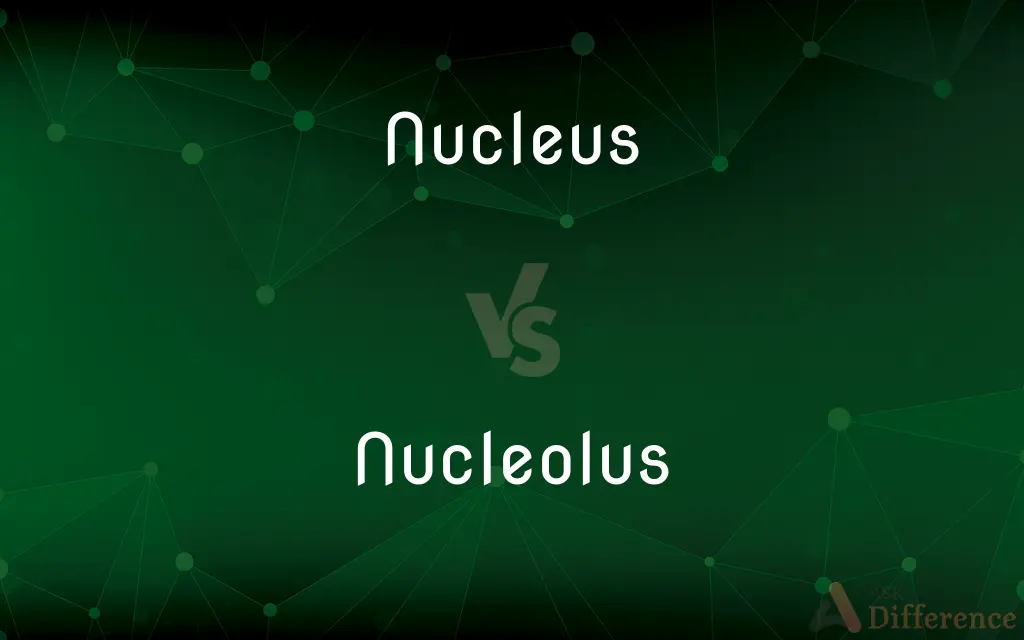Nucleus vs. Nucleolus — What's the Difference?
By Maham Liaqat & Urooj Arif — Updated on March 13, 2024
The nucleus is the cell's control center, containing genetic material and regulating activities, while the nucleolus, located within the nucleus, produces ribosomes and is essential for protein synthesis.

Difference Between Nucleus and Nucleolus
Table of Contents
ADVERTISEMENT
Key Differences
The nucleus is an organelle found in eukaryotic cells, characterized by its role as the control center, directing cell growth, metabolism, and reproduction through its DNA content. On the other hand, the nucleolus is a structure within the nucleus, primarily involved in assembling ribosomal subunits by transcribing and processing RNA.
While the nucleus houses the cell's chromosomes, making it critical for genetic information storage and transmission during cell division, the nucleolus focuses on ribosomal RNA (rRNA) production and ribosome assembly. These ribosomes are crucial for protein synthesis, a fundamental process for cell function and growth.
The nucleus is surrounded by a double-layered membrane, the nuclear envelope, which separates it from the cytoplasm and regulates molecule passage between the nucleus and the rest of the cell. In contrast, the nucleolus lacks a membrane, distinguishing it structurally and enabling it to fluidly assemble and disassemble according to cellular needs.
In terms of size and visibility, the nucleus is one of the largest organelles in a cell and can be observed under a light microscope. The nucleolus, while still visible under a microscope, is smaller and contained within the nucleus, often appearing as a dark spot.
The nucleus serves a broader set of roles, including storing genetic information, coordinating cell activities (such as growth, metabolism, and protein synthesis), and conducting cell division. Conversely, the nucleolus has a more specialized function, primarily concentrating on producing and assembling rRNA and ribosomes.
ADVERTISEMENT
Comparison Chart
Definition
Cell's control center, containing genetic material.
Structure within the nucleus, producing ribosomes.
Primary Function
Regulates cell growth, metabolism, reproduction.
Produces ribosomal RNA and assembles ribosomes.
Location
Eukaryotic cells, surrounded by nuclear envelope.
Within the nucleus, lacks a surrounding membrane.
Structural Characteristics
Double-layered membrane, contains chromosomes.
Membrane-less, visible as a dense spot in nucleus.
Role in Protein Synthesis
Contains DNA, which codes for proteins.
Directly involved in assembling proteins' machinery.
Compare with Definitions
Nucleus
Coordinates the cell's activities.
The nucleus directs the synthesis of proteins essential for cell function.
Nucleolus
Lacks its own membrane, allowing fluid assembly.
The nucleolus can change size based on the cell's needs.
Nucleus
Contains chromosomes made of DNA.
Chromosomes within the nucleus carry genes that determine traits.
Nucleolus
Visible as a darker area within the nucleus.
The nucleolus appears as a dense spot under the microscope.
Nucleus
Visible under a light microscope as a large organelle.
Staining cells reveals the nucleus as a prominent structure.
Nucleolus
Varies in number and size in cells.
Cells that produce a lot of proteins have larger nucleoli.
Nucleus
The cell's command center, containing its genetic blueprint.
The nucleus controls cell division and differentiation.
Nucleolus
Essential for protein assembly.
Ribosomes produced by the nucleolus translate RNA into proteins.
Nucleus
Surrounded by a nuclear envelope with pores.
The nuclear envelope regulates the entry and exit of molecules.
Nucleolus
A structure in the nucleus making ribosomal RNA.
The nucleolus is active in cells with high protein synthesis rates.
Nucleus
A central or essential part around which other parts are gathered or grouped; a core
The nucleus of a city.
Nucleolus
The nucleolus (, plural: nucleoli ) is the largest structure in the nucleus of eukaryotic cells. It is best known as the site of ribosome biogenesis.
Nucleus
Something regarded as a basis for future development and growth; a kernel
A few paintings that formed the nucleus of a great art collection.
Nucleolus
A small body in the nucleus of a cell that contains protein and RNA and is the site for the synthesis of ribosomal RNA and for the formation of ribosomal subunits.
Nucleus
(Biology) A membrane-bound organelle within a eukaryotic cell that contains most of the cell's genetic material. DNA transcription takes place in the nucleus.
Nucleolus
(cytology) A conspicuous, rounded body within the nucleus of a cell.
Nucleus
(Anatomy) A group of specialized nerve cells or a localized mass of gray matter in the brain or spinal cord.
Nucleolus
A little nucleus.
Nucleus
(Physics) The positively charged central region of an atom, composed of protons and neutrons, about which negatively charged electrons orbit. Extremely small and dense, the nucleus contains almost all of the mass of an atom.
Nucleolus
A small rounded body contained in the nucleus of a cell or a protozoan.
Nucleus
(Chemistry) A group of atoms bound in a structure, such as a benzene ring, that is resistant to alteration in chemical reactions.
Nucleolus
A small round body of protein in a cell nucleus; nucleoli contain RNA and are involved in protein synthesis
Nucleus
The central, often brightest part of the head of a comet.
Nucleus
The solid part of a comet, composed of ice and smaller amounts of dust and rock.
Nucleus
The central, often brightest part of a galaxy.
Nucleus
(Meteorology) A particle on which water vapor molecules accumulate in free air to form a droplet or ice crystal.
Nucleus
(Linguistics) The part of a syllable having the greatest sonority. In the word middlemost (mĭdl-mōst′) the nuclei of the three syllables are (ĭ), (l), and (ō); in the Czech word krk ("neck"), the nucleus is (r).
Nucleus
The core, central part of something, around which other elements are assembled.
Nucleus
An initial part or version that will receive additions.
This collection will form the nucleus of a new library.
Nucleus
The massive, positively charged central part of an atom, made up of protons and neutrons. Category:en:Nuclear physics
Nucleus
(cytology) A large membrane-enclosed organelle found in eukaryotic cells which contains genetic material.
Nucleus
(neuroanatomy) A ganglion, cluster of many neuronal bodies where synapsing occurs.
Nucleus
The central part of a syllable, most commonly a vowel.
Nucleus
A kernel; hence, a central mass or point about which matter is gathered, or to which accretion is made; the central or material portion; - used both literally and figuratively.
It must contain within itself a nucleus of truth.
Nucleus
The body or the head of a comet.
Nucleus
An incipient ovule of soft cellular tissue.
Nucleus
A body, usually spheroidal, in a eukaryotic cell, distinguished from the surrounding protoplasm by a difference in refrangibility and in behavior towards chemical reagents, which contains the chromosomal genetic material, including the chromosomal DNA. It is more or less protoplasmic, and consists of a clear fluid (achromatin) through which extends a network of fibers (chromatin) in which may be suspended a second rounded body, the nucleolus (see Nucleoplasm). See Cell division, under Division.
Nucleus
The tip, or earliest part, of a univalve or bivalve shell.
Nucleus
A part of the cell containing DNA and RNA and responsible for growth and reproduction
Nucleus
The positively charged dense center of an atom
Nucleus
A small group of indispensable persons or things;
Five periodicals make up the core of their publishing program
Nucleus
(astronomy) the center of the head of a comet; consists of small solid particles of ice and frozen gas that vaporizes on approaching the sun to form the coma and tail
Nucleus
Any histologically identifiable mass of neural cell bodies in the brain or spinal cord
Common Curiosities
Why is the nucleus important for cell function?
It houses DNA, regulating cell growth, metabolism, and reproduction, essential for the cell's survival and function.
What role does the nucleolus play in protein synthesis?
It produces and assembles ribosomal RNA and ribosomes, crucial for translating genetic codes into proteins.
Can a cell have a nucleus without a nucleolus?
Typically, cells with a nucleus also have a nucleolus, but the nucleolus may disassemble and reassemble depending on the cell cycle phase.
What distinguishes the nucleus from the nucleolus?
The nucleus is the cell's control center with genetic material, whereas the nucleolus is a structure within the nucleus focused on ribosome production.
Is the nucleolus always visible in the nucleus?
The nucleolus can be seen under a microscope as a dense area within the nucleus, but its visibility can vary based on the cell's activity.
Can the size of the nucleolus indicate cell activity?
Yes, a larger nucleolus often indicates higher protein synthesis activity within the cell.
Do all eukaryotic cells have a nucleus and nucleolus?
Most eukaryotic cells have a nucleus, and if they have a nucleus, they typically contain at least one nucleolus.
How does the structure of the nucleus and nucleolus differ?
The nucleus is surrounded by a double-layered membrane, while the nucleolus lacks a membrane and is found within the nucleus.
What happens to the nucleolus during cell division?
The nucleolus disassembles during cell division and reassembles in the daughter cells' nuclei.
Can environmental factors affect the nucleus and nucleolus?
Yes, factors like radiation, chemicals, and viruses can damage the nucleus and nucleolus, affecting their functions.
How many nucleoli can a nucleus have?
A nucleus can contain one or several nucleoli, depending on the cell type and its activity level.
Why does the nucleus have a membrane?
The nuclear membrane protects the DNA and regulates molecule passage between the nucleus and cytoplasm.
How do the nucleus and nucleolus interact with other cell organelles?
They coordinate with other organelles by regulating gene expression and protein synthesis, essential for cell function.
How are the nucleus and nucleolus studied in biology?
They are studied through microscopy, molecular biology techniques, and genetic analysis to understand their structure and function.
What is the significance of the nucleolus in genetic diseases?
Abnormalities in nucleolar function can disrupt protein synthesis, potentially leading to genetic diseases.
Share Your Discovery

Previous Comparison
Pedestrian vs. Sidewalk
Next Comparison
Flying vs. SoaringAuthor Spotlight
Written by
Maham LiaqatCo-written by
Urooj ArifUrooj is a skilled content writer at Ask Difference, known for her exceptional ability to simplify complex topics into engaging and informative content. With a passion for research and a flair for clear, concise writing, she consistently delivers articles that resonate with our diverse audience.
















































